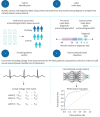An electrocardiogram-based AI algorithm for early detection of pulmonary hypertension
- PMID: 38936966
- PMCID: PMC11269769
- DOI: 10.1183/13993003.00192-2024
An electrocardiogram-based AI algorithm for early detection of pulmonary hypertension
Abstract
Background: Early diagnosis of pulmonary hypertension (PH) is critical for effective treatment and management. We aimed to develop and externally validate an artificial intelligence algorithm that could serve as a PH screening tool, based on analysis of a standard 12-lead ECG.
Methods: The PH Early Detection Algorithm (PH-EDA) is a convolutional neural network developed using retrospective ECG voltage-time data, with patients classified as "PH-likely" or "PH-unlikely" (controls) based on right heart catheterisation or echocardiography. In total, 39 823 PH-likely patients and 219 404 control patients from Mayo Clinic were randomly split into training (48%), validation (12%) and test (40%) sets. ECGs taken within 1 month of PH diagnosis (diagnostic dataset) were used to train the PH-EDA at Mayo Clinic. Performance was tested on diagnostic ECGs within the test sets from Mayo Clinic (n=16 175/87 998 PH-likely/controls) and Vanderbilt University Medical Center (VUMC; n=6045/24 256 PH-likely/controls). In addition, performance was tested on ECGs taken 6-18 months (pre-emptive dataset), and up to 5 years prior to a PH diagnosis at both sites.
Results: Performance testing yielded an area under the receiver operating characteristic curve (AUC) of 0.92 and 0.88 in the diagnostic test sets at Mayo Clinic and VUMC, respectively, and 0.86 and 0.81, respectively, in the pre-emptive test sets. The AUC remained a minimum of 0.79 at Mayo Clinic and 0.73 at VUMC up to 5 years before diagnosis.
Conclusion: The PH-EDA can detect PH at diagnosis and 6-18 months prior, demonstrating the potential to accelerate diagnosis and management of this debilitating disease.
Copyright ©The authors 2024.
Conflict of interest statement
Conflict of interest: H.M. DuBrock and R.P. Frantz report personal fees from Janssen Research and Development, LLC, a Johnson and Johnson company, outside the submitted work; and that additionally, Mayo Clinic may benefit financially from the algorithm described. T.E. Wagner, K. Carlson, C.L. Carpenter, S. Awasthi, M. Babu, A. Prasad, U. Yoo, R. Barve and V. Soundararajan are employees of nference, which received financial support from Janssen Research and Development, LLC, a Johnson and Johnson company, for work on this study. T.E. Wagner, S. Awasthi and V. Soundararajan also have patent application numbers 63/091,715 (non-invasive methods for detection of pulmonary hypertension) and 63/126,331 (systems and methods for diagnosing a health condition based on patient time series data) pending. K. Carlson, C.L. Carpenter, M. Babu, A. Prasad and R. Barve also have a patent application number 63/126,331 (systems and methods for diagnosing a health condition based on patient time series data) pending. Z.I. Attia, P.A. Friedman and S. Kapa have nothing to disclose apart from the fact that Mayo Clinic may financially benefit from the algorithm described in future. A.R. Hemnes, J. Annis and E.L. Brittain have no competing interests to report. S.J. Asirvatham reports personal fees from Abiomed, Atricure, Biotronik, Blackwell Futura, Boston Scientific, Medtronic, Medtelligence, Spectranetics, St. Jude, Zoll, Aegis, ATP, Nevro, Sanovas, Sorin Medical and FocusStart, outside the submitted work; and additionally, Mayo Clinic may financially benefit from the algorithm described in future. S.J. Asirvatham also receives royalties for work licensed through Mayo Clinic to a privately held company for contributions related to the use of nerve signal modulation to treat central, autonomic and peripheral nervous system disorders, including pain. Mayo Clinic receives royalties and owns equity in this company. The company does not currently license or manufacture any drug or device in the medical field. S.J. Asirvatham is a co-patent holder for technique to minimise coagulum formation during radiofrequency ablation. Products/techniques related to the above disclosures are not being discussed in this publication. M. Selej, P. Agron, E. Kogan, D. Quinn, P. Dunnmon and N. Khan are employees of Janssen Research and Development, LLC, a Johnson and Johnson company and own shares in the company.
Figures





Comment in
-
Artificial intelligence meets pulmonary hypertension: early detection for a late-presenting disease.Eur Respir J. 2024 Jul 25;64(1):2401138. doi: 10.1183/13993003.01138-2024. Print 2024 Jul. Eur Respir J. 2024. PMID: 39054042 No abstract available.
References
MeSH terms
LinkOut - more resources
Full Text Sources
Medical
